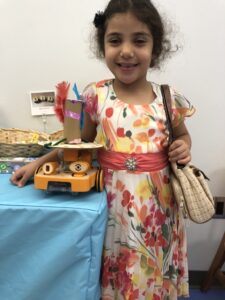Robotics in Early Childhood Education – Using PreK Coding Technology Breaks Down Engineering Stereotypes
In the fifth part of the blog series, we share key reasons why early childhood educators should be incorporating PreK coding and robotics in their classrooms. In this blog, we are focusing on Key #5 – Using Technology Breaks Down Engineering Stereotypes! See the other blogs in this series about the importance of robots in early learning with STEAM learning tools:
-
- Key 1 – Robotics in Early Childhood Education – Coding Teaches STEAM, the Literacy of the 21st Century
- Key 2 – Robotics in Early Childhood Education – Coding Develops Computational Thinking Skills
- Key 3 – Robotics in Early Childhood Education – Technology Becomes the Playground
- Key 4 – Robotics in Early Childhood Education – Robotics Makes Coding Tangible, Concrete…and Screen-Free!
- Key 6 – Robotics in Early Childhood Education – The Engineering Design Process Develops Grit and Perseverance
Early childhood is a wonderful time to sparks kids’ interest in coding, robotics, and engineering. Young children are naturally curious about the world around them. Today, that world includes technology. But how can educators promote positive, creative, and educational engagement with technology with our youngest learners? Integrating PreK coding and robotic STEM Kits for early learners is easier than you may think, with hands-on, screen-free tools like KIBO.
Robotics in Early Childhood Education – Using Technology Breaks Down Engineering Stereotypes!
 Scientific and technical fields suffer from a gender participation gap. Research shows that even in early childhood, children are already beginning to form opinions and stereotypes about which tools and technologies are better suited towards boys. By engaging young children in coding and robotics activities before these stereotypes begin to take root, we can help them build positive associations with technology and engineering and a self-image as a creator with technology.
Scientific and technical fields suffer from a gender participation gap. Research shows that even in early childhood, children are already beginning to form opinions and stereotypes about which tools and technologies are better suited towards boys. By engaging young children in coding and robotics activities before these stereotypes begin to take root, we can help them build positive associations with technology and engineering and a self-image as a creator with technology.
Dr. Amanda Sullivan was one of the researchers who helped develop KIBO. Dr. Sullivan recently published a new book drawing on her work: Breaking the STEM Stereotype: Reaching Girls in Early Childhood.
Dr. Sullivan’s research demonstrates that KIBO STEAM curriculum, when implemented in a developmentally appropriate way, can significantly increase girls’ interest in becoming an engineer. After an 8-week KIBO curriculum, 66% of girls expressed an interest in becoming an engineer, versus 36% prior to the curriculum. Due to this increase in girls’ interest, boys and girls had equal interest in engineering after the curriculum, despite a significant difference prior to the curriculum (58% for boys, 36% for girls in the pre-assessment). Learn more about the research behind KIBO.
Learn the 6 Key Benefits of Using Robotics with Your Youngest Students!
![]() Introduce coding and screen-free robotics into your early childhood classrooms – in a fun and playful way!
Introduce coding and screen-free robotics into your early childhood classrooms – in a fun and playful way!
Breaking the Gender Stereotype with Playful PreK Coding and Robotics
KIBO is purposefully designed with a neutral aesthetic and in gender neutral colors so that it is appealing to all children, starting in PreK. Though not all children will become engineers or computer programmers, a foundation in children’s robot kits and coding education gives children an opportunity to make that choice for themselves. KIBO includes building platforms to allow children to extend and decorate the robot with arts and crafts materials, providing an open-ended building and design experience which draws on a wide range of children’s interests.
Dr. Sullivan also recommends providing children with diverse role models as a way to counteract STEM stereotypes. Books are a great source of such role models. Here are a few examples of books for young children that feature female engineers and makers:
- Rosie Revere, Engineer – Andrea Beatty
- Hello Ruby – Linda Liukas
- The Most Magnificent Thing – Ashley Spires
Dr. Sullivan stated in the WIRED magazine article Can Robots Help Get More Girls Into Science and Tech, “I think that robots in general are novel to young children, both boys and girls…I think robotics kits like KIBO bring an air of excitement and something new to the classroom that gets kids psyched and excited about learning.”
KIBO’s PreK Coding Offers Playful Learning
KIBO, the coding robot, offers an inviting, engaging platform for young children to start their journey into creating with code. PreK coding can be fun and creative, where KIBO’s block-based coding language gives children control over the robot’s movements, sounds, and sensors, allowing them to express their imaginations with code. And, when accompanied by our STEAM curriculum, young children are able to tell stories, create characters, and explore their world with KIBO.
Learn more about how the KIBO Robot can teach the fundamentals of programming in a fun and engaging way and our mission to introduce coding to children by watching Dr. Marina Bers’ Tedx Talk – Young programmers — think playgrounds, not playpens.
Stay turned for the next blog on additional key reasons why robotics is important for young learners.
Supporting research:
- Sullivan, A. & Bers, M. U. (2016). Girls, boys, and bots: Gender differences in young children’s performance on robotics and programming tasks. Journal of Information Technology Education: Innovations in Practice, 15, 145-165.
- Sullivan, A., & Bers, M. U. (2013). Gender differences in kindergarteners’ robotics and programming achievement. International Journal of Technology and Design Education, 23 (3), 691-702.



















